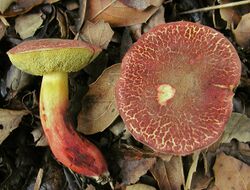Biology:Xerocomellus dryophilus: Difference between revisions
imported>Jslovo (fixing) |
(correction) |
||
| Line 6: | Line 6: | ||
| authority = (Thiers) N. Siegel, C.F. Schwarz & J.L. Frank (2014) | | authority = (Thiers) N. Siegel, C.F. Schwarz & J.L. Frank (2014) | ||
| synonyms = | | synonyms = | ||
}} | |||
{{Mycomorphbox | |||
| name = ''{{PAGENAME}}''{{italic title}} | |||
| hymeniumType = pores | |||
| capShape = convex | |||
| capShape2 = flat | |||
| stipeCharacter = bare | |||
| sporePrintColor = brown | |||
| sporePrintColor2 = olive-brown | |||
| howEdible = edible | |||
}} | }} | ||
'''''Xerocomellus dryophilus''''', commonly known as the '''oak-loving bolete''' and formerly known as '''''Boletus dryophilus''''' or '''''Xerocomus dryophilus''''', is a | '''''Xerocomellus dryophilus''''', commonly known as the '''oak-loving bolete''' and formerly known as '''''Boletus dryophilus''''' or '''''Xerocomus dryophilus''''', is a basidiomycete fungus in the family [[Biology:Boletaceae|Boletaceae]]. It was transferred to the new genus ''[[Biology:Xerocomellus|Xerocomellus]]'' in 2014. Its epithet had been previously applied to a European species, now described as ''Xerocomellus redeuilhii''.<ref>{{Cite journal |last=Simonini |first=Giampaolo |last2=Gelardi |first2=Matteo |last3=Vizzini |first3=Alfredo |date=2016 |title=Xerocomellus redeuilhii sp. nov. |journal=Rivista di Micologia}}</ref> | ||
It | The reddish cap is up to {{Convert|10|cm|frac=4}} wide and convex to plane.<ref name=":0" /> The pores are yellowish and often bruise blue, as does the flesh.<ref name=":0" /> The [[Biology:Spore print|spore print]] is brown. The stem is up to 12 cm long, yellow at the top and reddish below.<ref name=":0" /> It is similar to [[Biology:Xerocomellus chrysenteron|''X. chrysenteron'']] and ''Boletus smithii''.<ref name=":0" /> | ||
The species appears to only occur under ''[[Biology:Quercus agrifolia|Quercus agrifolia]]'' (coast live oak)<ref>{{Cite web|last=Stevens|first=Michael Wood & Fred|title=California Fungi: Xerocomellus dryophilus|url=http://www.mykoweb.com/CAF/species/Xerocomellus_dryophilus.html|access-date=2021-11-16|website=www.mykoweb.com}}</ref> and is only found in California, where it is one of the most common boletes in the Los Angeles and San Diego counties.<ref name=":0">{{Cite book |last=Arora |first=David |title=Mushrooms Demystified: A Comprehensive Guide to the Fleshy Fungi |url=https://archive.org/details/arora-david-mushrooms-demystified-a-comprehensive-guide-to-the-fleshy-fungi-ten-speed-press-1986/page/520/mode/2up |publisher=Ten Speed Press |isbn=978-0-89815-170-1 |location=Berkeley, CA |year=1986 |orig-date=1979 |edition=2nd |pages=520}}</ref> It is commonly parasitized by ''[[Biology:Hypomyces chrysospermus|Hypomyces chrysospermus]]''.<ref name=":0" /> It is [[Biology:Edible mushroom|edible]] but may be mediocre.<ref name=":0" /> | |||
==References== | ==References== | ||
| Line 18: | Line 28: | ||
==External links== | ==External links== | ||
*{{IndexFungorum|550688}} | *{{IndexFungorum|550688}} | ||
| Line 25: | Line 36: | ||
[[Category:Edible fungi]] | |||
{{Sourceattribution|Xerocomellus dryophilus}} | {{Sourceattribution|Xerocomellus dryophilus}} | ||
Latest revision as of 18:13, 12 July 2025
| Xerocomellus dryophilus | |
|---|---|

| |
| Scientific classification Error creating thumbnail: Unable to save thumbnail to destination
| |
| Domain: | Eukaryota |
| Kingdom: | Fungi |
| Division: | Basidiomycota |
| Class: | Agaricomycetes |
| Order: | Boletales |
| Family: | Boletaceae |
| Genus: | Xerocomellus |
| Species: | X. dryophilus
|
| Binomial name | |
| Xerocomellus dryophilus (Thiers) N. Siegel, C.F. Schwarz & J.L. Frank (2014)
| |
| Xerocomellus dryophilus | |
|---|---|
| Mycological characteristics | |
| pores on hymenium | |
| cap is convex or flat | |
| stipe is bare | |
| spore print is brown to olive-brown | |
| edibility: edible | |
Xerocomellus dryophilus, commonly known as the oak-loving bolete and formerly known as Boletus dryophilus or Xerocomus dryophilus, is a basidiomycete fungus in the family Boletaceae. It was transferred to the new genus Xerocomellus in 2014. Its epithet had been previously applied to a European species, now described as Xerocomellus redeuilhii.[1]
The reddish cap is up to 10 centimetres (4 in) wide and convex to plane.[2] The pores are yellowish and often bruise blue, as does the flesh.[2] The spore print is brown. The stem is up to 12 cm long, yellow at the top and reddish below.[2] It is similar to X. chrysenteron and Boletus smithii.[2]
The species appears to only occur under Quercus agrifolia (coast live oak)[3] and is only found in California, where it is one of the most common boletes in the Los Angeles and San Diego counties.[2] It is commonly parasitized by Hypomyces chrysospermus.[2] It is edible but may be mediocre.[2]
References
- ↑ Simonini, Giampaolo; Gelardi, Matteo; Vizzini, Alfredo (2016). "Xerocomellus redeuilhii sp. nov.". Rivista di Micologia.
- ↑ 2.0 2.1 2.2 2.3 2.4 2.5 2.6 Arora, David (1986). Mushrooms Demystified: A Comprehensive Guide to the Fleshy Fungi (2nd ed.). Berkeley, CA: Ten Speed Press. pp. 520. ISBN 978-0-89815-170-1. https://archive.org/details/arora-david-mushrooms-demystified-a-comprehensive-guide-to-the-fleshy-fungi-ten-speed-press-1986/page/520/mode/2up.
- ↑ Stevens, Michael Wood & Fred. "California Fungi: Xerocomellus dryophilus". http://www.mykoweb.com/CAF/species/Xerocomellus_dryophilus.html.
External links
Wikidata ☰ Q64785375 entry
 |

